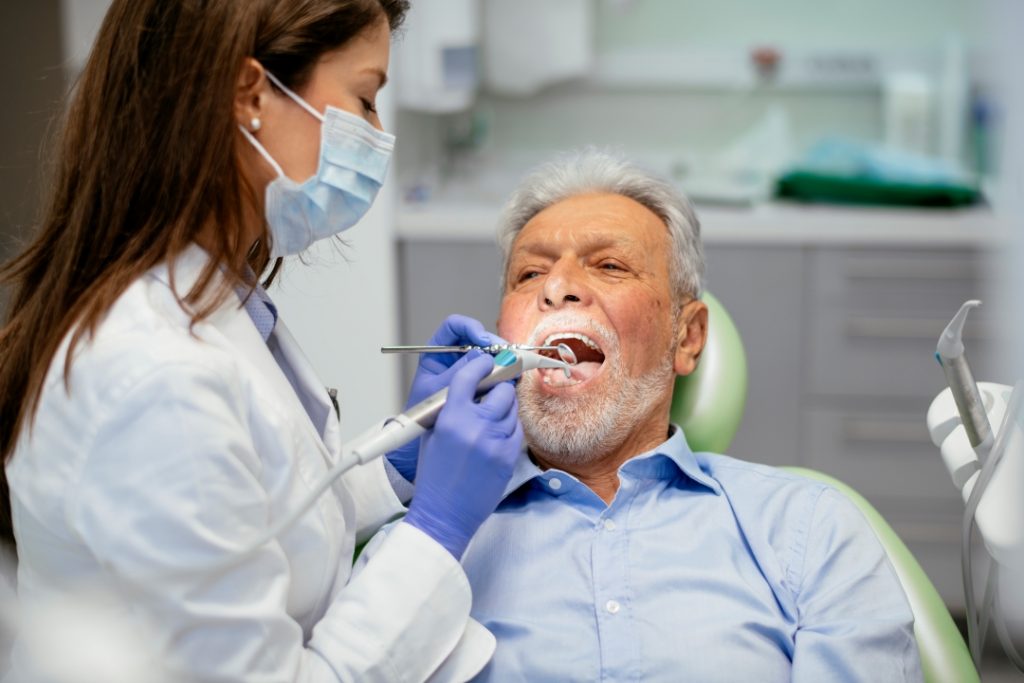Practicing the correct oral hygiene techniques is essential to keep your entire mouth healthy. The right dental habits lower your risk of developing periodontal disease or other problems. Routine care also allows you to recognize any changes in your oral health, so you can seek treatment immediately. Learn how to properly care for your teeth and gums to maintain good periodontal care and a beautiful smile.
Proper Brushing and Flossing Techniques
The first step in periodontal care is to develop good daily dental habits. You should brush your teeth at least twice each day, and floss at least once daily.
Brushing
Brushing removes the buildup of plaque and bacteria that creates a film on your teeth. When it isn’t brushed away, the plaque can become tartar or even start to develop into periodontitis.
You must brush your teeth twice each day at a minimum, including before you go to bed. Always choose your oral hygiene products carefully. Use a soft-bristled brush and toothpaste that has been approved by the ADA.
Hold your toothbrush along the gumline at a 45-degree angle. Use a circular motion to brush every surface of each tooth. Make sure you hit the inside, outside, and chewing surfaces. You can use the tip of your toothbrush for hard-to-reach areas like the inside of your front teeth. Also, be sure to brush your tongue for fresher breath.
Flossing
If you don’t already, start flossing at least once a day as part of your oral care routine. Flossing is the best way to clean between your teeth and reach under the gumline to remove bacteria and plaque.
Start with 12 to 18 inches of floss. Wind it around the index or middle finger of each hand until you have a length of one to two inches. Be gentle when you work the floss between your teeth. You don’t want to snap the floss onto your gums and damage them. Use a downward motion and pull the floss into a curve to clean every side. Readjust the floss to use a clean section for each tooth surface.
When you are finished brushing and flossing, be sure to rinse out your mouth.
Tips to Avoid Gum Disease and Bad Breath
Gingivitis is a mild form of gum disease. You normally notice bleeding of the gums, swelling, redness, or irritation. If this is not addressed, it can develop into more severe periodontitis.
Morning time and eating certain foods can lead to bad breath. In most cases, this is a minor annoyance. You can brush your tongue or use a tongue scraper to remove bacteria and control bad breath.
Fortunately, both gum disease and bad breath can usually be prevented by at-home treatment and dental habits:
- Attend your routine cleanings and checkups
- Drink plenty of water
- Brush and floss every day
- Use a mouthwash or antiseptic rinse
- Get a new toothbrush every two to three months
- Avoid tobacco
- Clean your bridgework or dentures thoroughly
Bleeding gums or an extreme case of bad breath may need Dr. Trujillo to address the issue. Make an appointment if you don’t get relief from following good oral care practices, or you have persistent symptoms.
Treatments for Bleeding Gums
Bleeding gums are a sign of gum disease. There are treatment options available to correct periodontitis. The one that is right for you depends on the severity of the gum disease and your unique situation. Dr. Trujillo may recommend one or more of the following:
- Deep cleaning is sometimes enough to remove the bacteria and beginnings of gum disease.
- Antibiotics may treat or limit the possibility of further infections.
- LANAP is a newer laser gum surgery that is less invasive and has a faster recovery time.
- Scaling is used to remove the buildup of plaque and tartar below the gumline. Root planing is then used to smooth out the root of the tooth so it can better reattach to the gum.
- Pocket reduction therapy may be needed if the gum disease was severe. Dr. Trujillo cleans away all signs of plaque and disease in the deep pockets around the tooth. Next, he will move the gum tissue back into the correct place and reattach it by stitching the gap closed.
Bleeding of the gums is not normal unless you have made a change to your oral care. If you experience bleeding that persists for several days, contact the Arizona Periodontal Group.
Solutions for Darkened Spots on Gums
Gum whitening treatment is a cosmetic procedure that can lighten dark or black spots on gums. These dark patches are harmless but can be addressed if you are concerned about how they look. Causes include poor oral care, lifestyle habits such as tobacco use, or even medications. However, more commonly, it is simply genetics.
There are two main methods for treating dark spots on gums. The first uses a whitening solution and then a technique called microdermabrasion. The second is laser treatment. Talk to Dr. Trujillo for recommendations on the best method for you.
Reverse Receding Gums
Receding gums come with the danger of causing decay or tooth loss. The best treatment for receding gums is the pinhole surgery technique. Dr. Trujillo makes a tiny, single hole in the gum tissue and then carefully loosens the gum tissue and maneuvers it into place to cover more of your tooth.
This procedure is fast and requires no downtime. Get instant results and get on with your day immediately after your appointment.
Arizona Periodontal Group’s Full Range of Periodontal Services
Receive a warm welcome and gentle care with every visit to Dr. Trujillo and the team at Arizona Periodontal Group. Every patient that enters the periodontal clinic is treated with compassion, and respect, and given the highest quality of care.
Address any dental concerns all in one place. Get your routine teeth cleanings, learn about preventative techniques, and find out more about cosmetic procedures. Discuss your concerns with Dr. Trujillo and explore all available treatment options.
Contact the office with any questions or check out the website to learn more about a specific service. Most importantly, schedule an appointment today to get the dental care you need for a brighter, healthier smile.






